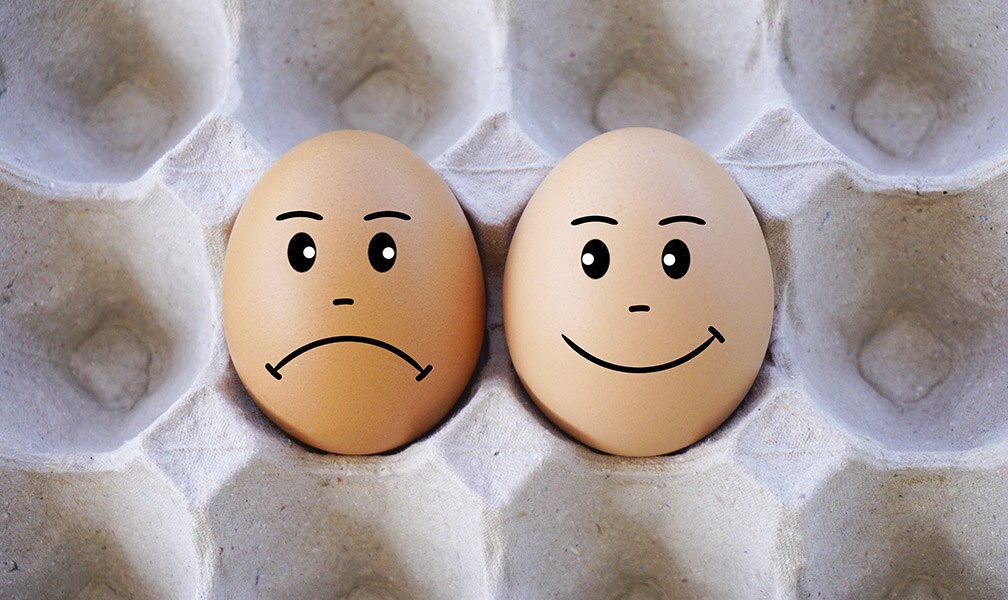Eggs and cholesterol
Eggs were long considered as perfect food, particularly for the quality of their protein. However, they declined in popularity in the 1980s when it was discovered that egg yolks are high in cholesterol and influence cardiovascular disease. Current studies show only a tenuous link between the cholesterol found in food, and cardiovascular disease.
Dietary cholesterol demonized in the 1970s
Egg consumption per capita varies greatly around the world, from a few dozen to over 250 eggs per person per year. In the early 21st century, world egg production reached 79.3 million tonnes, having increased by 152% in 30 years. China is the number one producer, accounting for 39% of worldwide production, followed by the US, which provides a mere 8%.
Although people have eaten eggs since time immemorial, eggs remained on the margins of the human diet for a very long time. This was possibly due to religious prohibitions or superstition, as well as for economic reasons, whereby it was more profitable to leave an egg to hatch into an animal. Over time, hens’ eggs overtook those of other species such as the ostrich, peacock or pigeon.
Until the 1970s, people considered eggs as nutritionally perfect, in particular for the quality of their protein. However, in the 1980s, eggs became less popular and sales of fresh eggs dropped after scientists discovered that egg yolks are high in cholesterol, accused of contributing to cardiovascular disease. Since studies now show only a tenuous link between dietary cholesterol and cardiovascular disease, eggs have gradually made a comeback.
Good and bad cholesterol
Cholesterol plays an essential role in creating cells, vitamin D and some hormones. The human body itself produces two thirds of the cholesterol it requires. The other third is absorbed from food.
Lipoproteins in our blood transport cholesterol to our cells or liver. ‘Good cholesterol’ is the kind that high-density lipoproteins (HDL) transport to the liver, where it will either be eliminated or metabolised. ‘Bad cholesterol’ is the kind that low-density proteins (LDL) transport to our cells. Excessive amounts of ‘bad cholesterol’ can form deposits on blood vessel walls. A high level of HDL in blood is a positive thing, as it helps protect us from cardiovascular disease.
Are eggs good or bad for your health?
A 60 g egg has an energy value of around 100 kcal and comprises 75% water, 13% protein and 10.5% lipids, of which 230 mg is cholesterol.
Eggs have protein in both the yolk and the white. They contain balanced proportions of the nine essential amino acids our bodies require. These amino acids are ‘essential’ in the sense that the body needs them but cannot produce them itself. We therefore have to get them from our food. Lipids are only found in the yolk, in the form of saturated, monounsaturated and polyunsaturated fatty acids, and cholesterol. A healthy body is able to regulate cholesterol naturally. If there is excess cholesterol in the diet, the body reduces the amount it produces and absorbs.
Eggs and the discovery of protein
Chemical analysis of egg whites was the catalyst for the discovery of protein in the early 19th century. This is why some languages use the same word for egg white and protein, as is the case with Eiweiss in German or ‘dànbái’ ( 蛋 白 ) in mandarin.
FoodTimeLine library, 2015. FAQs : eggs…Have questions ? [Tweet]. Twitter. [en ligne] le 6 janvier 2015. [Consulté le 6 mars 2017]. Disponible à l’adresse :
http://www.foodtimeline.org/foodeggs.html
Foodinaction, 2016. GUGGENBUHLN N. Œufs et cholestérol : une histoire ancienne ? [en ligne] le 17 février 2016. [Consulté le 9 mars 2017]. Disponible à l’adresse :
http://www.foodinaction.com/oeufs-et-cholesterol-une-histoire-ancienne/
INRA, 2013. L’œuf au trésor. [en ligne] .avril 2013. [Consulté le 9 mars 2017]. Disponible à l’adresse :
FAO. Nutrition. Les œufs en chiffre.[en ligne]. Avril 2015 [Consulté le 9 mars 2017]. Disponible à l’adresse :
http://www.fao.org/resources/infographics/infographics-details/fr/c/284414/
PASSEPORTSANTÉ.NET. Œuf. Encyclopédie des aliments [en ligne]. Janvier 2016. [Consulté le 13 mars 2017]. Disponible à l’adresse :
http://www.passeportsante.net/fr/Nutrition/EncyclopedieAliments/Fiche.aspx?doc=oeuf_nu
Good Food, Good Life. 2010. Graisses et Huiles. Nestlé Suisse S.A.:Vevey .2010





